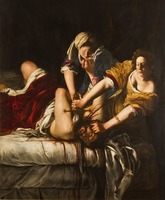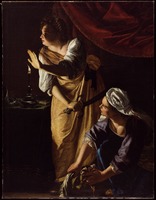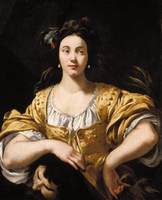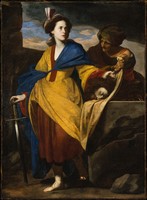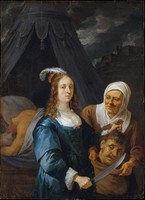Early to Late 17th Century
A bearded man lays in bed, a red and white bedsheet covering his modesty, head thrown back and a shocked expression on his face as two women behead him. This man is Holofernes and the women are Judith and her maidservant; the maidservant is wearing a blue gown and white headwrap and holds down Holofernes as Judith, wearing a gold gown with red sleeve accents, hold down his head and decapitates him with a sword. In true Baroque fashion, the scene is dramatized through the use of chiaroscuro, the figures emphasized by the blackened background.
The most celebrated female painter of the 17th century, Artemisia Gentileschi was born in Rome, the eldest of five children and the only daughter of the artist Orazio Gentileschi—whom she trained under. She worked as an apprentice to her father, and once she had advanced beyond his training, he hired the painter Agostino Tassi. A year later, Artemisia was raped by the painter, the infamous trial which followed having gone down in infamy.
Unlike a majority of Judith paintings, which show the scene of Judith beheading Holofernes after the fact—after he has already been beheaded—Gentileschi portrays the moment as Holofernes is being killed. The beheading is explicitly shown rather than implicit, Gentileschi not shying away from the gory details, and the effect is both powerful and frightening. Predictably, the most commonly met theory is that Gentileschi's images of this theme (of which she painted a couple, as well as other heroines in history such as Mary Magdalene) are autobiographical enactments of either her own experience with sexual violence, or its traumatic aftereffects, the cathartic expression of explicit revenge or repressed rage.
Two women are seen frozen in a moment of hesitation. The woman on the left wears a mustard yellow gown with puffy white sleeves, in her right hand she is holding a sword, her left hand risen almost as if she has overheard someone coming and is gesturing to her maidservant to stop. Her maidservant is dressed in rich purples and blues, a white wrap around her head, and looks up to her mistress' risen hand in anticipation. In the maidservant's hands we see the head of Holofernes himself, of which Judith has just killed with the sword in her hand. The entire scene is dramatized by the intense shadows.
The second of Gentileschi's Judith paintings, the first of which was painted five years prior, depicts Judith and her maidservant just after the act of beheading Holofernes. Whilst not as direct as her initial painting, she still depicts the subject with a directness that distinguish her from many other contemporary renditions. The theatrical lighting of the scene is reminiscent of the works of the followers of Caravaggio, while the intense realism of the scene is close to Caravaggio himself.
A woman with pale skin and dark hair is posed as if for a portrait. She is wearing a yellow gown with a white underdress, green and red feathers adorning her hair, and pearl earrings. She looks off to her left, the coinciding arm popped on her hip, the opposite on top of the severed head of a man with dark hair whose face is turned away from the viewer.
Born in Nancy, France ca. 1600, Charles Mellin spent a majority of his career in Roma. He was influenced by Italian artists such as Mola and Lanfranco, but more strongly by his fellow countrymen Nicolas Poussin and, above all, Simon Vouet.
Two women reside in what appears to be stone ruins. The woman on the left stands out among the brown monochrome composition; she is wearing a bright yellow gown with red accents, a royal blue cloak pulled across her shoulders. Her dark hair is pulled into an intricate updo, a white wrap with a ruby brooch made of feathers holding it together. In her left hand, she holds the severed head of a bearded man by the hair, placing it on a cloth offered to her by her maidservant; an older woman dressed in a similar palette to the rest of the composition. She wears a white headwrap, and looks at her mistress with a slight frown on her face. The woman on the left avoids both the look her maidservant gives her and the head, instead looking up to the heavens. In her right hand is the sword used to commit the crime, barely in her grasp as though to separate herself from it and, thus, what she has done.
Born 1585 in Orta di Atella, Italy, Massimo Stanzione was one of the leading Neapolitan painters of the Caravaggio School. His work was influenced by that of Jusepe de Ribera, but he was also interested in the work of Guido Reni. His style has been described as a more graceful and elegant form of Caravaggism, as well as a semi-Bolognese classicism.
Two women, one wearing a luxurious, royal blue gown and the other wearing a simple brown dress and white headwrap exit the tent of the Assyrian general Holofernes, his severed head in tow. The woman in blue, Judith, has auburn hair in ringlets framing her face which looks directly at the viewer. She is holding the head by the hair in her left hand, putting it into a burlap sack offered to her by her maidservant. In her right hand she is clutching tightly onto a sword, Holofernes’ eyes open and fearfully looking directly at the weapon. In the background, his body is shown, headless in bed. There is a storm brewing behind the blue war tent, stormy grey skies with a castle far off in the distance.
David Teniers the Younger was a Flemish artist born in Antwerp, Belgium in 1610. He studied with his father, David Teniers the Elder, who specialized in small-scale history paintings. He specialized in low-life genre scenes in a style derived from the work of Adriaen Brouwer. He had a close relationship with his fellow Flemish painter Sir Peter Paul Rubens, who is also credited for making a Judith painting 34 years prior in 1616.
